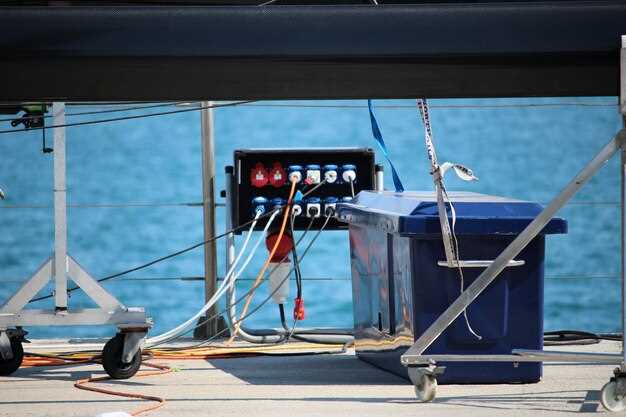
Electrical systems are crucial for the smooth operation of any boat. From powering navigation tools to lighting and onboard appliances, the reliability of your vessel’s wiring cannot be overstated. However, like any complex system, faults can arise, leading to inconvenient and potentially dangerous situations on the water.
Understanding how to diagnose these electrical problems efficiently is essential for every boat owner. Common issues often stem from faulty wiring, corroded terminals, or damaged circuits. Being equipped with the knowledge to identify these faults saves time and money, allowing you to enjoy your time at sea without unnecessary interruptions.
This guide aims to simplify the process of troubleshooting electrical systems in boats. By breaking down the necessary steps and providing practical tips, we will help you to quickly locate and resolve wiring faults. Navigating the complexities of marine electrical systems may seem daunting, but with the right approach, it can be manageable and straightforward.
Identifying Common Electrical Faults in Marine Vessels

Diagnosing electrical problems in boats requires a systematic approach to identify and resolve issues effectively. The most common electrical faults in marine vessels often stem from faulty wiring, corroded connections, or malfunctioning components.
One prevalent issue is poor connections. Over time, saltwater exposure can cause corrosion on wiring terminals and connectors. This leads to increased resistance and can result in intermittent power failures. Regular inspection and cleaning of these connections can mitigate such problems.
Another common fault is damaged wiring. Abrasion from movement, chafing against sharp edges, or even rodent damage can compromise the insulation of electric wires. When the wiring is exposed, it poses a safety risk and potential failure of the electrical system. It’s crucial to inspect the wiring harness thoroughly and replace any compromised sections.
Electrical systems in boats also rely heavily on the battery. Weak batteries can cause a host of issues, including insufficient power to start engines or operate onboard electronics. Testing the battery’s voltage regularly and ensuring it is properly charged is essential for maintaining a functional electrical system.
Short circuits are another significant concern. They usually occur when current flows through an unintended path, potentially causing damage to wiring and onboard equipment. Identifying the source of a short circuit involves tracing the wiring and checking each connection for signs of wear or disruption.
Lastly, equipment malfunction can stem from outdated or defective electrical components. Fuses, circuit breakers, and switches can fail over time, leading to loss of functionality. Regular checks and replacements of these components ensure that the electrical system remains operational and reliable.
Step-by-Step Guide to Troubleshooting Boat Wiring Issues
Identifying electrical faults in your boat’s wiring can be a straightforward process if you follow a systematic approach. Start by ensuring that you have the necessary tools, such as a multimeter, wire strippers, and electrical tape.
1. Visual Inspection: Begin with a thorough visual inspection of all wiring and connections onboard. Look for signs of wear, corrosion, or breaks in the wires. Pay special attention to connections at terminals and junction boxes, as these are common points for faults.
2. Check the Battery: Ensure that the battery is fully charged and functioning correctly. Use a multimeter to measure the voltage. A healthy battery should read around 12.6 volts when fully charged. If the voltage is low, consider charging or replacing the battery.
3. Test Circuit Continuity: With the multimeter set to the continuity mode, test each wire in the circuit. Disconnect the power before conducting this test to avoid damage. Place one probe on each end of the wire to check for continuity. A lack of continuity may indicate a break in the wire.
4. Examine Fuses and Breakers: Inspect all fuses and circuit breakers for faults. A blown fuse or tripped breaker often indicates a short circuit or overload in the system. Replace any blown fuses and reset breakers as needed.
5. Isolate Components: If a particular electrical device, such as a bilge pump or navigation light, isn’t working, disconnect it from the circuit. Test the circuit again to determine if the issue lies within the device or the wiring itself.
6. Use the Multimeter for Voltage Testing: With the circuit powered on, use the multimeter to test for voltage at various points along the wiring. Ensure you have voltage where it should be present. If you detect a significant voltage drop, isolate and examine that section of the wire for issues.
7. Look for Grounding Issues: A faulty ground connection can lead to erratic electrical behavior. Check all ground connections and ensure they are secure and free of corrosion. Clean and re-establish poor connections as necessary.
8. Document Findings: Keep a record of any faults discovered during your troubleshooting process. This documentation can help you track recurring issues and assist in communicating with professionals if further work is required.
By following these steps, you can effectively diagnose and address electrical faults within your boat’s wiring system, ensuring a safer and more reliable experience on the water.
Tools and Techniques for Accurate Electrical Diagnostics in Boats

When it comes to diagnosing electrical problems in boats, having the right tools and employing effective techniques are essential for identifying wiring faults accurately. A well-organized toolkit can significantly streamline the troubleshooting process, allowing boat owners and technicians to pinpoint issues swiftly.
One of the primary tools for electrical diagnostics is a multimeter. This device measures voltage, current, and resistance, helping to determine if the electrical circuits are functioning correctly. Checking for continuity in wiring can reveal hidden faults, such as breaks or damaged wires. Ensure you calibrate the multimeter before use to obtain precise readings.
Additionally, a circuit tester can be invaluable for verifying the integrity of connections. It provides a straightforward way to check for power at various points in the system, which is crucial when isolating circuits that may have faults affecting the entire boat.
When investigating issues within the wiring, it’s important to use visual inspection techniques. Look for signs of wear, corrosion, or loose connections. Corroded terminals can disrupt power flow and need immediate attention. Regular inspections can help prevent more severe issues from developing.
Using a wire tracer can simplify locating specific wiring runs, especially in complex layouts. This tool helps identify which wire corresponds to each circuit, making it easier to address faults without unnecessary guesswork. It can also assist in determining if wires have become damaged or are shorting out.
Finally, employing a diagnostic software tool compatible with the boat’s electrical systems can provide deeper insights into electronic faults. By connecting to the onboard systems, it can read error codes, allowing for a more thorough analysis and targeted repairs.
In conclusion, equipping yourself with the right instruments and adopting systematic techniques is crucial for effective electrical diagnostics in boats. Accurate identification of wiring faults not only enhances safety but also ensures smooth operation on the water.



